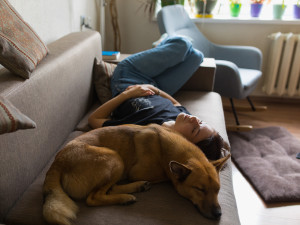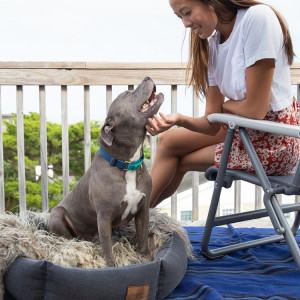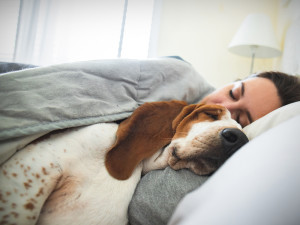Why Dogs Burrow Under the Covers (And Dig In the Bed)
What’s behind the desire and whether it’s safe to do.

Share Article
If you live with — and let’s be honest, sleep with — certain pups, there is likely the equivalent of a subway system of tunnels underneath the covers of your bed. Well-worn paths that your beloved dog has burrowed through, night after night. What’s the deal with dogs who burrow under the blankets (or dig in bed), and is this behavior safe?
Certain breeds of dog are more inclined to burrow under the covers or dig in bed, and in general, such denning is not detrimental to their health. But some blanket options are safer than others, and dogs of certain ages and breeds need to be more closely monitored when they hunker down this way. With just a little know-how about dogs’ burrowing behavior, we can rest more easily alongside our comforter-loving pups.
Which Breeds Are Prone To Burrowing?
If you cohabitate with a Terrier or Dachshund, you’ve probably witnessed some blanket-digging behavior. These breeds historically were raised to drive vermin out of underground dens, and their ancestors were accustomed to creating and squeezing into tight spaces in order to flush out rodents. Therefore, they instinctively feel comfortable within, say, a dark and cozy duvet. Huskies, too, are apt to burrow under the covers, as their Arctic ancestors dug holes in the snow and nestled in them for insulation (as do current-day sled dogs when on the trail). Though specialists in dog behavior tend to name these three breeds as poster pups for denning, any dog can exhibit blanket-burrowing behavior.
Why Do Dogs Burrow?
Ancestors of the domesticated dog settled in tunnels and caves to protect themselves and their young from predators and inclement weather, and today’s canines intuitively seek comfort in spaces they associate with the coziness of a den. Because they’re pack animals, dogs also tend to search for modern-day equivalents of the warmth and sense of security derived from curling up against their littermates. They find these comforts in the act of sleeping alongside their human “pack members” and nestling beneath blankets that smell soothingly of themselves or their human parents.

Dogs also burrow as a way to recharge after a day of stressors (you know, how you like to bury under the covers after a bad day at work). “By removing exposure to the sights and sounds of an active household, the dog feels more secure,” says JustAnswer veterinarian Jo Myers, DVM. “After all, it’s your dog’s job to keep an eye on everything going on in and around the house so she can make sure her family is safe,” she says. “When your dog is buried under the blankets in your bed, they can turn off that vigilance and take a break.” Something we can definitely relate to.
In addition, being under the covers places a barrier between the pup and any loud noises, such as fireworks or rainstorms. Like a Thundershirt or similar swaddling vest, bedcovers can provide anxiety-reducing pressure to the body of the nervous animal — think of it as their snuggie.
Is Burrowing Safe For Dogs?
For the most part, yes. Healthy adult dogs will thermoregulate — that is, remove themselves from beneath the blankets — when they become too hot. As long as they have an easy exit out of their “dens,” there is little danger in allowing them to dive under the covers. This said, it may be difficult for puppies and smaller breeds to ‘evacuate’ certain types of bedding. In addition, older canines and those with respiratory issues (including flat-faced dogs like Pugs) can have a difficult time breaking free from especially big or heavy blankets. To minimize the opportunity for overheating or entanglement, it’s best to avoid such coverings.
Which Blankets Are Potentially Harmful To Burrowers?
If your pup can’t get out from underneath a blanket — especially one of those weighted blankets us insomniacs have purchased — it’s not safe. Same goes for a blanket with pockets or openings in which pups could become trapped (duvet covers, for instance). Also, dogs’ teeth or nails can snag in blankets with holes or loose ends, causing them to become stuck in their hidey-holes. “Avoid allowing your dog to burrow in blankets that have become so worn that they’re stringy and look more like a net than a blanket,” warns Dr. Myers. Of course, heated blankets and heating pads — with their electrical cords and quick-warming properties — may also lead to a dangerously sweltering sleep environment and even thermal burns. Experts recommend choosing bed covers made from breathable, hard-to-chew fabrics like fleece, microfiber and mesh.
Can Burrowing Indicate Anxiety Issues?
Blanket-burrowing in dogs generally is nothing to sweat about. However, if the digging seems obsessive or is partnered with panting or crying, separation anxiety could be the culprit. You can help release your dog’s tension by providing them with ample exercise and toy stimulation before leaving them on their own. Dog-sitters or a doggy day care also may be useful in minimizing your pup’s attachment issues. This said, if excessive burrowing persists even after the animal’s fear trigger has been identified and removed, the behavior could point to a larger phobia. Ask your vet for recommendations for behavior modification techniques and/or medications based on their assessment of your dog’s compulsive conduct.

Joan Kubicek
Joan Kubicek is a writer, performer, pet-sitter, and dog-mom to a curmudgeonly Terrier named Lyle. She lives in Los Angeles.
Related articles
![Small dog humps its teddy bear toy on the room floor]()
Humping. Why, Though?!
No less than 7 animal behaviorists weigh in on what’s behind all of this bumping and grinding.
![Shiba inu dog sleeping in bed]()
My Dog Sleeps All Day—Is That Normal?
Dogs need more sleep than humans. Here’s how much is healthy.
![a human petting a dog on a dog bed]()
The Best Dog Beds Of 2025
Our dogs sleep with us, too. But these trainer-recommended dog beds—from indestructible ones for puppies to orthopedic options for seniors—are the next best thing.
![Woman and dog sleeping together in bed]()
Where Should Your Dog Sleep at Nighttime?
It’s a personal preference, but here are the pros and cons.




